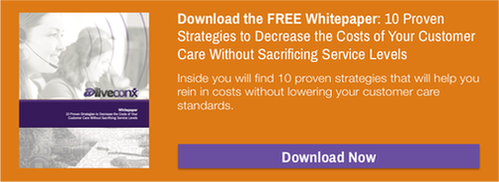Contact Centre Satisfaction: Crucial KPIs to Monitor for Measuring Success
Setting and achieving contact centre success benchmarks can best be done by identifying and regularly monitoring key performance goals (KPIs).
What are KPIs?
Key performance indicators, or KPIs, are significant measurable metrics an organization can utilize to gauge the success or failure of projects, departments, and initiatives. KPIs are varied and numerous, and determining which performance indicators are worth collecting, discarding, and analyzing can be tricky. Dedicating valuable resources to the wrong metrics or ignoring critical key performance indicators happens all the time. According to the Advanced Performance Institute, only 10% of all KPIs collected are used to inform decision-making, with 90% of data collected either being wasted/discarded, or worse yet, “used to drown people in data while they are thirsting for insights.”
Fortunately, customer service KPIs have been refined for decades, which makes tracking and measuring them a little easier. Here are a handful of contact centre key performance indicators worth your time.
Customer Service
If a customer hangs up feeling frustrated or the appropriate information isn’t being conveyed, you’re doing something wrong. These KPIs can help measure the level of your contact centre’s overall customer service:
- Customer satisfaction: This metric is usually measured with the tried-and-true “this call will be monitored and recorded for customer service purposes” method. Contact centre interactions can be analyzed and scrutinized for agent efficiency, overall customer satisfaction, and opportunities for improvement.
- First call resolution (FCR): If an agent is able to address a concern and a caller can navigate customer service successfully during their first call, that’s good for business. While the average net FCR rate for service desks was 74% in 2011, success varied anywhere from 41% to 94%. Businesses on the more successful end of the spectrum were able to utilize highly trained contact centre agents who always had the proper tools at their disposal.
- Queue wait time: Average time spent waiting on hold or being passed around departments can weigh heavily on a caller’s patience. The more time spent in the queue, the less satisfied a customer is with your service quality.
- Abandonment rate: When a caller is in the queue for longer than anticipated or if issues aren’t being addressed, there’s a chance that caller will hang up. Keeping abandonment rates low should be a contact centre goal.
Agent Efficiency
Well-trained, well-equipped customer service agents make all the difference. Use these KPIs to measure efficiency:
- Call duration/Average call length: Simply put, how long does an agent spend on the phone with an individual caller? It’s best to be helpful and thorough, and an agent that can be both in a short amount of time is invaluable. That said, don’t sacrifice call quality to reduce average handle times. Instead, leverage the two for best results.
- Wrap-up time: After hanging up, how much time is it taking agents to finish work related to the call? More time spent off the phone doing follow-up work means fewer calls taken. Training and workflow management can help lower wrap-up times.
(Average handle time and wrap-up time are often measured together as “occupancy rate” – the amount of time an agent spends on-call and doing post-call work)
- Response time and wait time: Both KPIs are variations of how long a caller is kept in the queue. Response time is the average time it takes to answer calls (e.g. 80% of all calls are answered within 20 seconds). Wait time is how long (shortest, average, longest) it takes for a caller to connect with an agent.
- Self-service: Today, intuitive self-service options are being implemented. Determining how many callers, on average, are able to complete a call through automated customer service methods can help optimize your contact centre.
Cost Analysis
Use the following key performance indicators to monitor costs that directly affect contact centre operations and efficiency:
- Cost per contact: An effective way to measure average cost per contact is to select a timeframe (hourly, daily, weekly) and divide average handle and wrap-up times by all contact centre costs for that particular timeframe.
- Turnover rate: Losing contact centre agents affects service quality, especially if untrained new hires are replacing experienced agents. Provide incentives and create a great contact centre culture to keep turnover rates low.
- Absenteeism: How often are current agents conforming to schedules, and is absenteeism a problem? Assess and address accordingly.
The future of customer service is evolving before our eyes, and building a successful contact centre strategy requires intelligently digging into important KPIs and setting goals against those metrics. These are just a few key performance indicators that contact centres regularly measure, but there are plenty more worth applying and analyzing.
Which KPIs are you measuring? Do you want to learn more about essential KPIs for contact centre success? Check out our free white paper!










